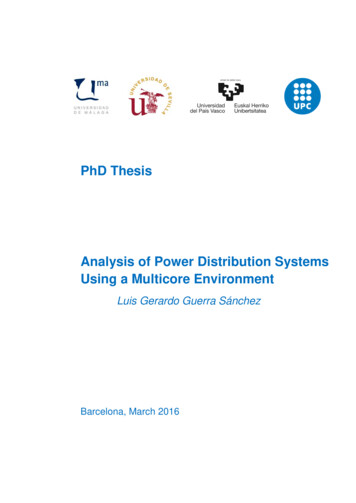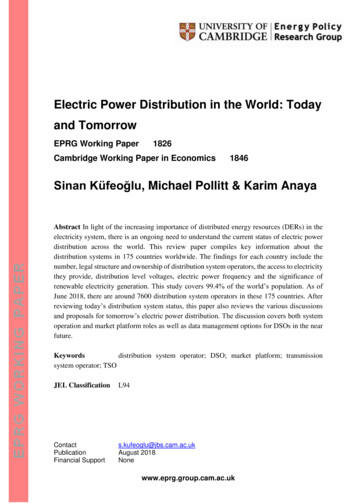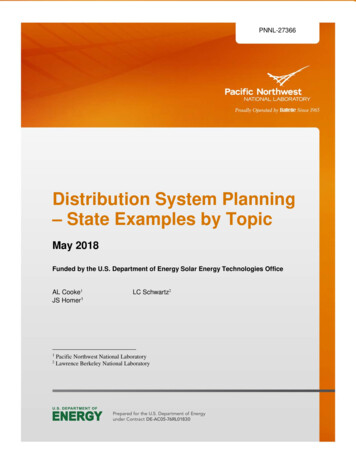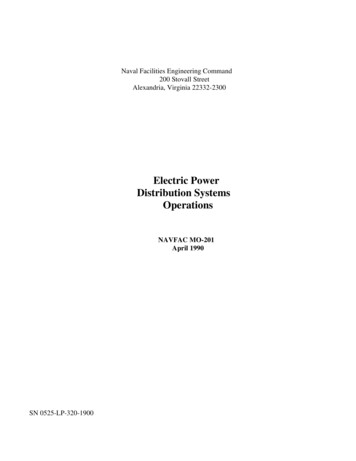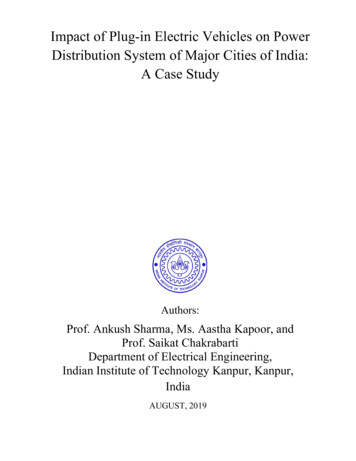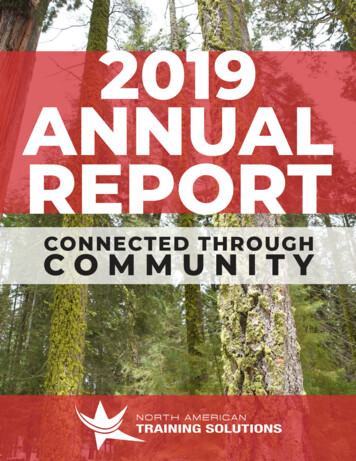
Transcription
Electric Distribution SystemPlanning with DERs –High-level Assessment ofTools and MethodsMarch 2020JS HomerY TangJD TaftAC OrrellD NarangM CoddingtonM IngramA HokePNNL-28138
PNNL-28138DISCLAIMERThis report was prepared as an account of work sponsored by an agency of the United Statesgovernment. Neither the United States government nor any agency thereof, nor any of theiremployees, makes any warranty, express or implied, or assumes any legal liability orresponsibility for the accuracy, completeness, or usefulness of any information, apparatus,product, or process disclosed, or represents that its use would not infringe privately owned rights.Reference herein to any specific commercial product, process, or service by trade name,trademark, manufacturer, or otherwise does not necessarily constitute or imply its endorsement,recommendation, or favoring by the United States government or any agency thereof. The viewsand opinions of authors expressed herein do not necessarily state or reflect those of the UnitedStates government or any agency thereof.
PNNL-28138Electric Distribution System Planningwith DERs – High-level Assessmentof Tools and MethodsJS HomerY TangJD TaftAC OrrellMarch 2020D NarangM CoddingtonM IngramA Hoke
PNNL-28138Executive SummaryElectric distribution system planning supports investment decisions and operations strategies. Itis a broad subject with many facets. The increasing number of distributed energy resources(DERs)1 connected to the grid is changing how utilities perform their distribution planningprocess. The adoption of DERs is based on a combination of several factors including statepolicy incentives, favorable economics, consumer preferences, and the provision of reliable andresilient power, for example through the application of energy storage and microgrids. Thisreport assesses the planning tools and methods available for utilities performing distributionsystem planning with DERs and identifies the gaps that exist, as well as future functionality thatwill be needed.The report is part of a larger ongoing effort through the U.S. Department of Energy’s GridModernization Laboratory Consortium and is a companion to the report, Summary of ElectricDistribution System Analysis with a Focus on DERs, which was published in April 2017.iInformation in this report can assist stakeholders (including utility personnel, regulatory bodies,technology manufacturers, product and software vendors, think tanks, and researchorganizations) as they plan for and begin to participate in integrated distribution system planningactivities, regulatory proceedings, or tool development.Growing numbers of DERs on the distribution grid are increasing the speed of grid dynamics,which in turn requires better grid observability (sensing and measurement) and faster controls.This process requires higher-performance communications networks with more complexinterface requirements. Some early-adopter states are taking a methodical approach forconducting a high-level assessment of needs that accounts for the structure of the grid, andtools needed to help prioritize and evaluate options. The increasing adoption of DERs ischanging utilities’ distribution system planning processes. Utilities must account for increaseduncertainty due to DERs and need to evaluate potential future scenarios. To remain flexible andadaptable to changing conditions and technology development, scenario analysis, granularforecasting, and options analysis are becoming increasingly important in integrateddistribution system planning.Utilities need accurate, granular data to develop system models, validate results, and performanalysis. Collecting the data needed for integrated distribution system planning analysis meansutilities must install new measurement, sensing, and communication technology, as well ascapture ongoing field changes to make sure that electronic models are up to date and representthe current state of operation. Obtaining the necessary data can be a significant challenge forutility planners and other decision makers, and it can require significant time and cost. Withoutgranular, accurate data of the distribution system all the way to the premise level, analysis islimited, and results can be inaccurate. Therefore, it is essential that utilities and regulatorsmake strategic, targeted data collection a priority including identifying data gapsThe National Association of Regulatory Utility Commissioners (NARUC) defines a DER as “a resourcesited close to customers that can provide all or some of their immediate electric and power needs and canalso be used by the system to either reduce demand (such as energy efficiency) or provide supply tosatisfy the energy, capacity, or ancillary service needs of the distribution grid. The resources, if providingelectricity or thermal energy, are small in scale, connected to the distribution system, and close to load.Examples of different types of DER include solar photovoltaic (PV), wind, combined heat and power(CHP), energy storage, demand response (DR), electric vehicles (EVs), microgrids, and energy efficiency(EE).” NARUC, Distributed Energy Resources Rate Design and Compensation, 2016.1iii
PNNL-28138associated with specific analyses of interest and developing strategies for filling thosegaps. This can be done in a proportional manner according to need (spatially and/ortemporally).The more advanced analysis also necessitates new tools and approaches, and it requires newexpertise to perform the analysis. Forecasting the number of future DERs deployments isimportant for distribution system planning, but it is challenging in part because DER deploymentis dependent on policies and tariffs, which can be influenced by the distribution system planningprocess itself. While there are emerging tools that can provide utilities with granular load andDER forecasts, a tool capable of evaluating different DER deployment scenarios andpolicies and then automatically updating projections based on actual deploymentpatterns would be helpful for utility planners and regulators.Power flow analysis plays a key role in traditional distribution system operation and planning,but it is evolving to consider changing operating conditions, as more DERs are connected to thedistribution system. DERs create more variable supply and demand, so it is no longer enoughfor utility planners to consider only peak-load conditions at periodic instances in time. Utilitiesare beginning to utilize time series power-flow analysis (TSPFA) to understand the impact ofDERs. TSPFA is a time-series grid simulation composed of multiple steady-state power-flowcalculations with user-defined time step sizes between each calculation. TSPFA at short timesteps can require significant computational times and iterative solvers. While some utilities donot have the granular system data necessary for TSPFA, other utilities do not have theexpertise or computing power. In research domains, a variety of proposed “fast TSPFA”approaches have emerged, but more work is needed.Several tools are needed that could assist utility planners, including commercial toolsthat move beyond hosting capacity screens and automatically generate solutions whenhosting capacity or interconnection analyses identify an issue. Utilities have numerousoptions for mitigating issues, including controls, capacitors, battery storage systems,reconfiguring circuits, or demand-side solutions, and these can be used in a multitude ofcombinations. Traditional distribution system analysis tools (CYME, Synergi, Milsoft), as well asresearch tools (GridLAB-D and OpenDSS), can be used to manually perform analysis andexplore different solutions. But no tools exist that can provide an automated review and assesspotential solutions to interconnection studies or hosting capacity analyses and then recommendthe best resource or combination of resources to meet system needs. A tool that couldautomate this process and help utilities identify and evaluate options would allow for a quickerassessment of solutions and could inform conversations with developers and customers.More robust tools are needed that can simulate distribution systems with multipledevices, such as smart inverters and energy storage, simultaneously operatingautonomously. Tools are needed that can co-simulate the distribution and transmissionsystems, as well as DER, under different scenarios to determine reliability, protection, and thesuitability of non-wires alternatives. Although tools exist—such as DER-CAM, ReOpt, andHOMER—that optimize DERs at the campus or microgrid levels, they do so based on balanceof energy equations rather than engineering power flow analysis. Engineering tools thatincorporate power flow analysis are needed for selecting optimum type, sizing, andplacement of DERs at the distribution system scale.Table S.1 contains a summary of key gaps and challenges for distribution system planning withDERs.iv
PNNL-28138Table S.1. Summary of Gaps and Challenges for Distribution System Planning with DERsAreaData and feeder modelsGrid architectureProjecting DERsTime-series power flowanalysis (TSPFA)Hosting capacityanalysis andinterconnection studiesCharacterizinglocational value,including identifyingnon-wires alternativesCo-simulation andadvanced optimizationsEquipment andtechnology-specificgapsChallengesDeveloping required data sets to conduct detailed analysesManaging the sheer amount of data and daily configuration changesBreaking down data silos at utilitiesStandardizing data formats between applicationsMaking sure validated and calibrated feeder models are kept up to dateCapabilities to readily determine grid service requirements for different systemconfigurations, e.g., microgrids and other non-traditional topologies Tools for planning an observability strategy and/or sensor allocation plan Tools for integrating communication networks and distribution circuit planning Tools that plan for the use of markets and market-like mechanisms for DERintegration and coordination Commercial/mature tools that project customer adoption rates of DERs taking intoconsideration policies and existing deployment rates Streamlined methods for conducting TSPFA to reduce computation times Dynamic and transient analysis capabilities for assessing frequency and inertiaimpacts of DERS Tools that identify best resource combinations (including controls, capacitors,circuit reconfiguration, storage, or demand-side solutions) to mitigate hostingcapacity exceedances Analysis associated with protection coordination Real-time updating and semi-automated interconnection request evaluation Tools that automatically provide a set of appropriate non-wires alternatives givensystem needs Tools that identify value based on DER physical impact assessments Resilience, reliability, & power quality impact characterizations of DERs Commercial tools that characterize impacts of DERs with full smart inverter and/orstorage functionality Improved usability and scalability of distribution/transmission co-optimization tools Tools for optimizing the type, number, size, and location of DERs in distributionsystems based on engineering analysis Capability to characterize transmission and distribution integration impacts andimpacts of advanced technologies such as demand response, electrification, andenergy storageSmart Inverters Tools that model all smart inverter functions More robust tools to simulate many smart inverters operating independently Smart inverter manufacturer information for tool developmentBattery Storage A battery valuation tool that addresses multiple use cases and co-optimizesacross the bulk, distribution, and customer systems, including ancillary services Distribution scale tools that support the sizing and location of battery systems Manufacturer battery storage information for tool developmentFlexible loads Incorporation of market-activated flexible loads and the associated short-runmarginal costs or other price signals into commercial toolsMicrogrids Real microgrid data for tool testing and development Dynamic modeling of microgrids in commercial tools or commercial co-simulationtools that link microgrid tools with traditional distribution system analysis toolsElectric Vehicles (EVs) Specific EV manufacturer information for modeling Commercial tools that support projecting EV adoption and charging behavior v
PNNL-28138Acronyms and AbbreviationsAMIAdvanced metering infrastructureASancillary servicesCAMCustomer Adoption ModelCPUCCalifornia Public Utilities CommissionDERdistributed energy resourceDERACDER Avoided Cost CalculatorDOEU.S. Department of EnergyE3Environmental Economics, Inc.EPRIElectric Power Research Institute, Inc.EVelectric vehiclesFINDERFinancial Impacts of Distributed Energy ResourcesFNCSFramework for Network Co-simulationGISgeographic information systemGMLCGrid Modernization Laboratory ConsortiumHELICSHierarchical Engine for Large-scale Infrastructure Co-simulationIECInternational Electrotechnical CommissionIEEEInstitute of Electrical and Electronics EngineersIESMIntegrated Energy System ModelIOUInvestor-Owned UtilitiesLBNLLawrence Berkeley National LaboratoryLNBALocational Net Benefits AnalysisMCSSmarginal cost of services studiesNISTNational Institute of Standards and TechnologyNRELNational Renewable Energy LaboratoryNWAnon-wires alternativesPNNLPacific Northwest National LaboratoryPSLFPositive Sequence Load FlowPSS/EPower System Simulator for EngineeringPVphotovoltaicROMDSTRemote Off-grid Microgrid Design Support ToolsRPSrenewable portfolio standardsSAMSystem Advisor ModelT&Dtransmission and distributionTSPFAtime series power-flow analysisvi
PNNL-28138ContentsExecutive Summary . iiiAcronyms and Abbreviations . viContents . viiList of Figures . ixList of Tables . ix1.0Introduction . 12.0Growing Importance of Distribution Planning . 23.0Foundational Elements . 53.1Validated and Calibrated Feeder Models. 53.2Accurate and Granular Data . 63.3Grid Architecture . 84.0Analysis Areas for Planning with DERs . 114.1DER and Load Projections – Multiple-Scenario Forecasts .114.1.14.1.24.2Time-Series Power Flow Analysis .154.2.14.2.24.3Tools . 26Gaps . 26Coordinating T&D Planning .274.6.14.6.24.7Tools and Approaches for Conducting Locational Value Assessments . 21Research Tools that Support Locational Value Assessments . 23Advanced Functionality Needed . 25Enterprise-Level Analysis and Planning Platforms .264.5.14.5.24.6Tools and Approaches . 17Advanced Functionality Needed . 18Locational Value Analysis .194.4.14.4.24.4.34.5Tools . 15Advanced Functionality Needed . 15Hosting Capacity and Interconnection Studies .164.3.14.3.24.4Tools and Approaches for Developing Forecasts . 12Advanced Functionality Needed . 14Emerging Tools . 27Advanced Functionality Needed . 27Advanced Optimizations .284.7.14.7.2Tools . 28Advanced Functionality Needed . 29vii
PNNL-281385.0Technologies and Applications that Factor into Distribution SystemPlanning Analysis. 305.1Smart Inverters .305.1.15.1.25.2Energy Storage .325.2.15.2.25.3Tools . 35Advanced Functionality Needed . 36Microgrids .365.4.15.4.25.5Tools . 32Advanced Functionality Needed . 33Flexible Loads .345.3.15.3.25.4Tools . 31Advanced Functionality Needed . 31Tools . 36Advanced Functionality Needed . 37EVs .385.5.15.5.2Tools . 38Advanced Functionality Needed . 396.0Conclusion . 407.0References . 41viii
PNNL-28138List of Figures1.2.3.4.Integrated Distribution System Planning . 3Network of Structures Model for the Grid . 8Planning/Markets/Control Spectrum . 9Components of California’s LNBA Tool .22List of TablesS.1.1.2.3.4.5.6.7.8.9.10.11.12.13.14.Summary of Gaps and Challenges for Distribution System Planning with DERs . vMultiple-Scenario Forecast Tools and Methods .14Time Series Power-Flow Analysis Tools and Methods .16Hosting Capacity Tools and Methods .18DERAC Deferral Benefit Module Inputs (E3 2017) .22Components of Electricity Avoided Costs Calculated by DERAC .23Tools and Methods for Assessing Locational Value in Distribution System Planning .26Enterprise Analysis and Planning Platforms for Distribution System Planning .27Advanced Optimization Tools and Methods for Distribution System Planning .29T&D System Co-simulation Tools and Methods for Distribution System Planning .28Smart Inverters in Distribution System Planning .32Energy Storage in Distribution System Planning.34Flexible Loads in Distribution System Planning .36Microgrid in Distribution System Planning.38Electric Vehicle in Distribution System Planning .39ix
PNNL-281381.0 IntroductionElectric distribution system planning supports investment decisions and operations strategies. Itis a broad subject with many facets. This report focuses on distribution system planning withdistributed energy resources (DERs) and assesses the capability of current planning tools andmethods that can identify needed system requirements that will make certain of reliable andeffective operations with DERs. As utilities face increasing adoption levels of DERs, moregranular analysis (temporally and spatially) becomes necessary, which is changing how utilitiesconduct distribution planning. Factors that impact distribution planning include cost, safety,reliability and resilience, operational efficiency, customer satisfaction, aging infrastructure, andgrowing adoption of renewable and other distributed resources.This report provides an overview of the tools available to assist utility planners in performingvarious analyses; the gaps that are not currently addressed by existing tools; and newemerging areas of analysis. The tools include computer models and software, as well as otheranalytical aids and practices that support distribution planning. DERs include (1) generationsources located on the distribution system, such as solar photovoltaic (PV) systems, windgenerators, hydro generation, geothermal generators, natural gas, and diesel generators;(2) battery electric storage systems; (3) demand response and transactive energy systems; and(4) energy efficiency technologies.As part of a larger, ongoing effort by the U.S. Department of Energy’s (DOE’s) GridModernization Laboratory Consortium (GMLC), the goal is to address analytical tools andmethods to support integrated electric distribution system planning. This report is a companionto Summary of Electric Distribution System Analysis with a Focus on DERs, which waspublished in April 2017.ii While the 2017 report focused on types of distribution system analysesneeded to understand the impacts of DERs, this report focuses on tools and methods used indistribution system planning.While the analysis for this report made an effort to assess the tools and approaches available toindustry, the tools evaluated represent the capabilities available and may not be an exhaustivelist of all commercially available tools. This information can assist stakeholders (including utilitypersonnel, regulatory bodies, technology manufacturers, product and software vendors, thinktanks, and research organizations) as they plan for and begin to participate in more detaileddistribution system planning activities, regulatory proceedings, or tool development andactivities that include DERs.1
PNNL-281382.0 Growing Importance of Distribution PlanningThe purpose of electric distribution system planning is to assess needed physical andoperational changes to the local grid in order to maintain safe, reliable, and affordable service.Distribution planners must consider a vast number of factors and constraints as they work toforecast new growth, serve loads, and maintain reliability.While electric utilities have always engaged in some type of electric distribution systemplanning, distribution planning is becoming increasingly complex and is receiving more attentiondue to the changing nature of the grid, increased interdependencies, and growing numbers ofcustomer-owned resources.Traditional distribution system planning has a short time horizon of one to three years andlimited involvement by state utility regulators; however, the focus is shifting to longer timehorizons and a more holistic or integrated process, with greater transparency and moreinvolvement by regulators and other energy stakeholders. It is becoming a more collaborativeprocess whereby stakeholders can provide input and review projections, assumptions, andanalysis results in a more structured way.State policy goals and utility business objectives set the context for distribution system planningand grid investments. In many states, general assemblies, utility regulatory commissions, andother policy-making organizations set specific requirements, mandates, or state goals aroundreliability and resilience, grid modernization, greenhouse gas emissions, and/or renewableenergy targets that can impact utility operations, planning, and procurements. Utility businessobjectives within the larger regulatory and prudence framework also play an important role ininvestment decisions.As a result, a growing number of states and utilities are beginning to consider a comprehensivedistribution system planning process to address the costs and benefits of DERs; to reflect theadditional choices coming from the customer/third-party domains; to integrate with resource andtransmission planning; and to incorporate scenarios that reflect the dynamic and changingnature of the electricity system. Some states use distribution system planning to characterizethe ability of the local grid to accommodate DERs and to characterize the location and timebased value of DERs to the grid. Additionally, these comprehensive distribution system planningprocesses facilitate discussions and input from stakeholders, help to inform state policies, andprovide information for other key stakeholders in the state.Advanced distribution system planning, in contrast to traditional distribution system planning,requires the evaluation of many interdependencies involving different aspects of planning.These interrelationships between planning for system resources, distribution, transmission, andoperations are evolving.iii Figure 1 illustrates the many components and interactions inintegrated distribution planning as defined in a report by Paul DeMartini and ICF for theMinnesota Public Utilities Commission.iv2
PNNL-28138Figure 1. Integrated Distribution System Planning*This figure was obtained from Paul De Martini of Newport Consulting. See Endnote v.The interdependencies between the different planning areas introduce new variables and createcomplexity. In the past, planning only needed to consider one-way power flow and a very limitednumber of distributed resources. Now, planners must understand the potential for andimplications of a significantly larger number of DERs, and they must perform increasinglycomplex analyses to account for the many variables that can impact future-load and generationrequirements. This added complexity necessitates the need for flexible and adaptiveapproaches to implementing integrated distribution systems. Using real options analysis todesign flexibility into utility roadmaps and investment and implementation plans can be valuablefor utilities and customers by accounting for unforeseeable technologies and services that arelikely to emerge over time. Real option analysis is an alternative approach to resource decisionmaking and may result in greater benefits to the customer than net present value or benefit costapproaches for infrastructure investments that can be undertaken incrementally, such as for gridfield devices or communication networks.vCollecting the data needed for integrated distribution system planning analysis means utilitiesmust install new measurement, sensing, and communication technology. The more advancedanalysis also necessitates new tools and approaches and requires new expertise to perform theanalysis.3
PNNL-28138To assist with efforts, some utilities are contracting with external vendors or consultants for datacollection, managem
of energy equations rather than engineering power flow analysis. Engineering tools that incorporate power flow analysis are needed for selecting optimum type, sizing, and placement of DERs at the distribution system scale. Table S.1 contains a summary of key gaps and challenges for
